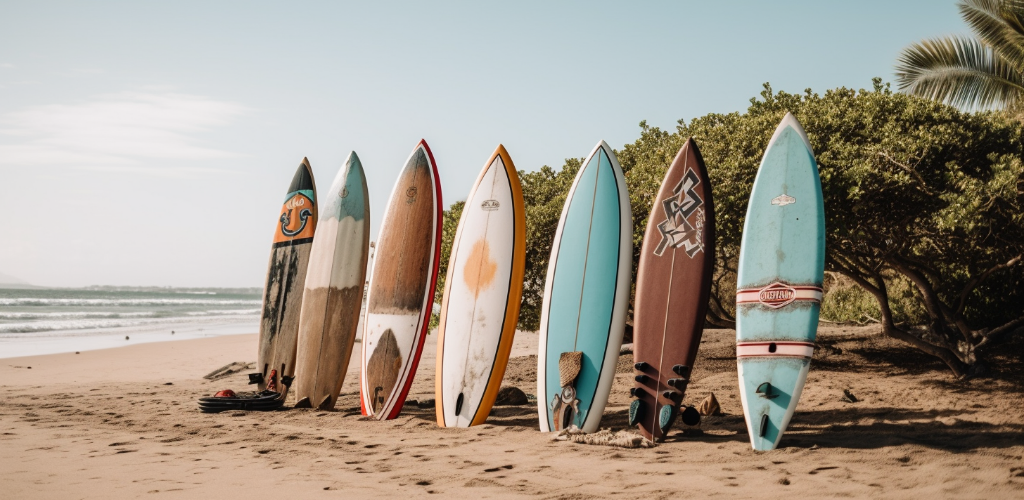Ever wondered about the origins of your sleek, modern surfboard? The history of surfing is a tale as old as time, deeply rooted in ancient Polynesian culture, and the surfboard has evolved right along with it. From the earliest wooden planks to today’s high-tech designs, the surfboard’s journey is a captivating story of innovation, culture, and the unending human quest to ride the waves.
The Start of Surfing
Surfing, as we know it today, traces its origins back to Polynesian culture. It was more than just a sport or pastime; surfing held significant religious and ceremonial value. Isn’t it fascinating how a simple act of riding the waves had such profound cultural importance?
Surfers were respected figures in Polynesian society, and their surfboards, often painstakingly crafted, played a significant role in this. These early surfboards were a far cry from what we see today, but they were the stepping stones to the modern designs we now know and love.
Early Surfboards: Materials and Manufacturing
So, what were these early surfboards made of? The answer lies in the lush forests of the Polynesian islands. The prime material used for the early surfboards was wood, specifically from trees that were abundant in the area.
The process of creating these early boards was labor-intensive and required a great deal of skill. An artisan would carefully select a suitable tree, chop it down, and then begin the arduous process of carving and shaping it into a surfboard. This was a work of art, a labor of love, and the resulting surfboards were highly prized possessions.
It’s interesting to note that these early surfboards were not just tools for sport; they were also considered sacred objects, imbued with spiritual significance. Each board was unique, reflecting the individuality of its creator and owner. Imagine the pride and reverence with which these early surfers must have handled their boards!
Types of Wood Used in Early Surfboards
Have you ever wondered what early surfboards were made of? The answer might surprise you – they were predominantly made from wood! But not just any wood, specific types were favored for their unique properties and availability. Let’s take a closer look.
Koa Wood
Koa wood was a popular choice for early Hawaiian surfboards. Native to the Hawaiian Islands, this type of wood was readily available and had properties that made it ideal for surfboard construction. But what made Koa wood so special?
Firstly, Koa wood is known for its strength and durability, making it an excellent material for withstanding the powerful waves of the Hawaiian surf. Additionally, Koa wood has a natural buoyancy, which made early surfboards made from this wood easier to maneuver in the water. Finally, the rich, deep color of Koa wood gave these early surfboards a distinctive and beautiful appearance that is still admired today.
Balsa Wood
When we talk about early surfboards, we cannot overlook the importance of Balsa wood. Known for being extremely lightweight yet strong, Balsa wood was another preferred choice in the creation of early surfboards.
Balsa wood’s lightweight nature made surfboards easier to carry and handle, both in and out of the water. However, despite its lightness, Balsa is surprisingly strong and durable, capable of withstanding the impact of waves. Furthermore, Balsa wood is easy to shape, making it an ideal material for experimenting with different surfboard designs.
The Evolution of Surfboard Design
With the passage of time, the design of surfboards witnessed a significant evolution. Early surfboards were simple, long, and straight, primarily designed for straight-ahead surfing. So, what led to the change in design?
The answer lies in the quest for better maneuverability and control. As surfing became more popular, surfers began to experiment with different surfboard shapes and sizes in an effort to improve their surfing experience.
Longer boards, known as ‘longboards’, were found to provide greater stability and were ideal for beginners. Shorter boards, on the other hand, offered more agility and were preferred by more experienced surfers looking to perform tricks and turns. The introduction of fins further revolutionized surfboard design, providing better directional control and stability.
Thus, through a process of experimentation and innovation, the design of surfboards evolved over time, reflecting the changing needs and skills of surfers. Isn’t it fascinating how much thought and innovation goes into something as simple as a surfboard?
The Influence of Modern Technology on Surfboards
Can you imagine the world of surfing without the influence of modern technology? The advent of new materials and manufacturing techniques has drastically changed the surfboard industry. Today’s boards are lighter, stronger, and more durable than their wooden counterparts. But how did this change come about?
As technology advanced, so did the materials used for surfboards. In the mid-20th century, fiberglass and foam replaced the traditional wooden boards. This shift happened for a few reasons. Fiberglass and foam are lighter and easier to shape than wood, providing more flexibility and maneuverability to the surfer. These materials also offered more consistent performance and durability, leading to their widespread adoption in the surfing world.
Environmental Impact of Surfboard Materials
But what about the environment? As we became more aware of our environmental footprint, the surfboard industry started to look for more sustainable options. Traditional surfboard materials like fiberglass and polyurethane foam have a significant environmental impact. They are derived from non-renewable resources and their manufacturing process releases harmful pollutants into the atmosphere. But don’t worry, the industry has been making strides towards more sustainable practices.
Today, many surfboard manufacturers are opting for more eco-friendly materials. For instance, some are using plant-based resins and recycled foam. Others are going back to the roots and making wooden surfboards using sustainably sourced timber. These efforts are not only good for the environment but also preserve the art and tradition of surfboard making.
Comparison of Surfboard Materials
| Material | Use | Advantages | Disadvantages |
|---|---|---|---|
| Wood | Used in early surfboards and some modern ones | Strong, durable, and sustainable | Heavy and requires a lot of work to shape |
| Fiberglass | Commonly used in modern surfboards | Light, flexible, and easy to shape | Derived from non-renewable resources and environmentally harmful |
| Foam | Commonly used in modern surfboards | Light, buoyant, and easy to shape | Derived from non-renewable resources and environmentally harmful |
| Plant-based resins and recycled foam | Used in eco-friendly surfboards | Sustainable and environmentally friendly | May not be as durable or perform as well as traditional materials |
Appreciating the Art of Surfboard Making
Have you ever stopped to appreciate the beauty and craftsmanship that goes into creating a surfboard? It’s not just about the ride; it’s about the art, the history, and the tradition. Let’s take a moment to admire the skill and dedication that went into hand-carving the early surfboards. Every detail, every curve, every groove was meticulously crafted to provide the perfect ride.
Modern Surfboards vs. Early Surfboards
Now, let’s take a look at how surfboards have evolved over the years. It’s fascinating to see how technology and innovation have transformed the design and materials used in surfboards. But how do modern surfboards stack up against the early, hand-carved wooden boards?
Modern surfboards, while offering more precision and performance, lack the charm and character of early surfboards. The synthetic materials used in modern boards, though lightweight and durable, cannot replicate the natural beauty of the wooden boards from the past.
- Material: Modern boards are typically made from synthetic materials like foam and fiberglass, while early boards were made from wood, primarily Koa and Balsa.
- Weight: Early wooden surfboards were significantly heavier than modern foam-based boards. This made them more difficult to maneuver but gave a unique riding experience.
- Shape: Modern surfboards come in a variety of shapes and sizes to suit different wave conditions and riding styles. Early boards, however, had a more uniform, elongated design.
- Production: Modern surfboards are mass-produced using machines for precision and consistency. In contrast, early surfboards were hand-carved, making each board unique.
The Future of Surfboards
So, what does the future hold for surfboards? With the pace of technological advancements, it’s hard to predict exactly. However, one thing is clear: the surfing industry is leaning towards sustainable and eco-friendly materials. More and more manufacturers are exploring alternatives to traditional foam and fiberglass, such as plant-based resins and recycled materials.
Design-wise, the trend seems to be moving towards a blend of old and new. Retro designs inspired by early surfboards are making a comeback, but with a modern twist. As we look ahead, it’s exciting to imagine what innovative designs and materials will shape the future of surfboarding.
Isn’t it fascinating to see how far we’ve come from the early wooden boards to the modern, high-tech surfboards we see today? It truly is a testament to human creativity and innovation. And who knows? Maybe the surfboards of the future will draw even more inspiration from the past.




